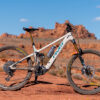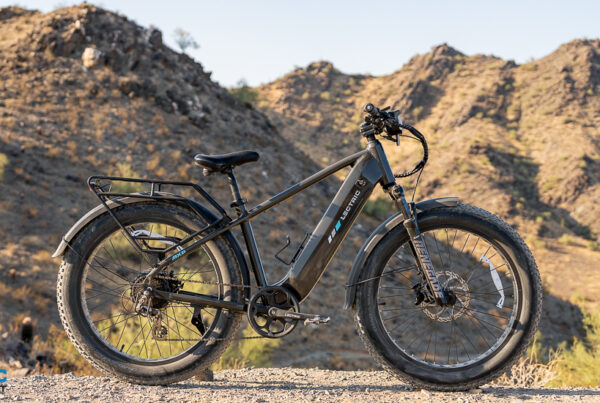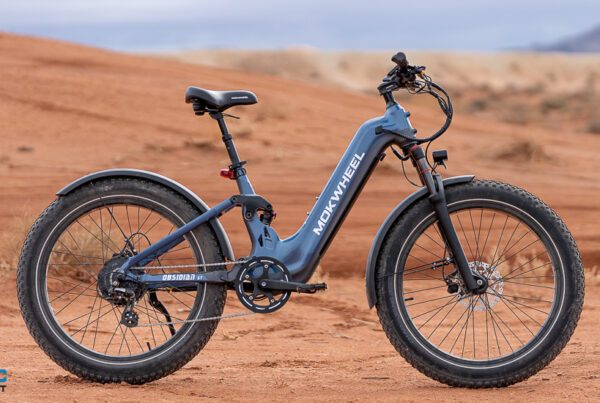In this week’s news:
- UK Bike Shops Deemed Essential in New Lockdown
- CLIP BIKE Friction Drive Relaunched
- Pullit! The folding trailing that packs down onto your bike
- Powerful DIY Carbon Full Sus eMTB Build
- Belt vs Chain Efficiency
- Cycle Lane Update
- Bafang Launch Direct to Dealer Service
Headline News
UK Bike Shops Deemed Essential Again As Country Enters Second Lockdown
On Wednesday 6th of January most of the UK entered a second lockdown, with only listed shops and services allowed to say open. Cycling Industy News reports that ‘Listed among the transport services permitted to stay open bike shops will again be allowed to operate in full, offering sales and workshop services, though it is advisable to have a policy in place limiting the number of customers in store at once.’
With a huge boom in e-bike sales in 2020 the article also notes that many bike shops may be struggling for something to sell: ‘There will be a marked difference between this lockdown and the spring lockdown last year, during which the bike industry proceeded to sell through inventory at a record pace. This time around a significant supply chain hangover means that a scrabble for available stock will leave many short on supply if demand in any way mirrors prior form. So strong has the demand been it has forced industry giants such as Shimano to reassesses supply chain functionality.’
New eBikes & eBike Systems
CLIP BIKE Friction Drive Available for Preorder
The unusual looking CLIP BIKE kit offers friction drive power
The idea of friction drives is alluring because of their simplicity and this design from CLIP BIKE sums up many of their advantages; at 7lbs / 3kgs total weight CLIP is lightweight and removable to lighten the bike even further and has an attractive price tag of US$399. Originally launched back in spring 2019 this version is a second production run.
Paper spec says a 450W motor and 144Wh battery combo gives a max assisted speed of 15mph. It should fit 26″ and 28″ front wheels and comes with a one year warranty.

The CLIP BIKE system is removable
So why aren’t friction drives more popular? Whilst various designs have come and gone over recent decades, they all seem to have suffered from common weaknesses that include a lack of raw power, slipping in the wet and in the worst cases damaging the tyres that they rely on to transfer their power to the bike via friction. Will CLIP BIKE fare better than the many previous attempts? Only time will tell.
New Bike & eBike Accessories
Pullit! A mini-folding bike trailer.

The Pullit! trailer folds away when not needed
Pullit! is a bicycle and e-bike trailer that can be stowed inconspicuously over your rear wheel.
Stated max payload is a respectable 66lbs / 30kg. Claimed weight for the trailer 10.2lbs / 4.6kgs which is pretty light for a trailer but the loading area of 18.5 x 16.5 inches / 47 x 42 cm is fairly modest. It retails at 399 euros with various compatible bags and baskets costing extra.
According to the manufacturer the Pullit! fits most common bike and e-bike designs – regardless of whether or not a luggage rack is available. Without a luggage rack, the trailer is simply attached to the seat post and can be removed from there for use. A bag can also be carried on top of the folded trailer whilst it’s on the bike.
Whilst there have been other similar designs in the past the Pullit looks a particularly neat and well-thought through example of the concept.
Get Inspired
DIY Build – the sub US$5400 Full Carbon eMTB
Hats off to the UK’s Rob Rides EMTB for this interesting Youtube video on his build of a full-carbon frame fitted with a powerful 3.4kg Bafang M500 mid drive. He bought the full carbon frame direct from Dengfu, painted it then fitted it out with an 850Wh battery pack and high spec wheels, brakes and suspension. Quoted weight was 24.5kg.
Why? Full carbon, full-sus e-mtbs are generally over £6000 / (though the cheapest UK model we found after a quick google was Cube’s Stereo Hybrid 140HPC at £3699 / circa US$5000, admittedly with a smaller battery). Final cost of the Rob Rides emtb, excluding his considerable labour, was some £4049 or around US$5400.
If you are thinking of having a go yourself do bear in mind Rob Rides’ comments as below:
‘Doing a DIY build like this also has negatives. It takes a fairly long time to build, shop for parts etc, especially in the current situation with delayed / restricted stock! You need tools etc, time to build. And not the best support when you need help. Warranty etc will also take time if I need it. BUT its very rewarding building your own! And you can choose the parts that you really like. For many folks, a direct / shop bought bike is by far the best option, all things considered. Yes, you spend more, but the support is (usually) much better. But great to see this DIY build as a feasible option for those who would like to give it a go.’
Step Inside the Rad Lab

A sample frame for checking in the Rad Lab.
Rad Power Bikes make a wide range of well-priced e-bikes and recently gave you an insight into how they design and test their bikes at the Rad Lab.
Take the journey from concept, through CAD design and beyond. With their 3D printer the Rad Lab say they can iterate in days what would take months to do through a factory sample process. Then comes testing to US and EU standards – these are ‘fatigue, durability, and impact tests, including dropping the frame and mechanically simulating an extreme ride. If any visible cracks or fractures appear, the engineering team goes back to the drawing board.’
Rad Lab then gets together all the sample parts and creates a camouflaged test ride “mule” – ‘a bare-bones version of the latest model, usually covered in tape so we can hide our logo from prying eyes. The prototypes are then widely tested including some ‘testing to destruction’ which Rad Lab say ‘is the most popular part’. They also have at their disposal a dynamometer, a machine that lets the team test direct drive and geared hub motors for torque, speed, and responsiveness.
A 100% production sample undergoes final testing before it’s put into production.
E-bike Tech
Belt vs Chain Efficiency

Construction of a Gates Carbon Belt Drive
Belt drives are being fitted to more and more e-bikes instead of the traditional chain drives. They don’t need oil and regular maintenance but are said to be a little less efficient than chain drives. This set of three videos has all sorts of technical info for those interested in such things and in particular has an interesting comparison of the efficiency of worn belts and chains.
Of course you need to bear in mind the videos are produced by Gates so will no doubt emphasise those areas where belts excel over chains. It does seem that belt drives certainly need to be tensioned properly to perform at their best so if your e-bike features a belt drive it might be worth getting it checked out by a retailer who you know has expertise in this area. It’s also worth noting that the videos show most losses in belt efficiency come at low speeds, implying belt drives would be a good choice for long tours where regular higher speeds are maintained but less efficient for stop/start town riding.
There’s more detail from Gates on their conclusions in this sponsored post.
Infrastructure
More Bike Parking for NYC Says Report

There are calls for more secure cycle parking in NYC to encourage cycling, like this example actually from California’s Bay Area Rapid Transit system (BART)
Bicycle Industry and Retailer News reports:
‘A nonprofit bicycle and pedestrian rights group released a comprehensive report advocating for more secure bicycle parking in the city, arguing that this deficiency suppresses commuting and has a disproportionate impact on lower-income residents and people of color.
Transportation Alternatives released The Power of Bicycle Parking: An Easy, Affordable and Effective Way to Save Lives, Encourage Cycling, and Create a Fairer New York City on Tuesday. It provides specific recommendations for improving bicycle parking infrastructure across the five boroughs, saying people are less likely to ride when parking is unavailable. Despite lacking secure parking locations, bicycle commuting in New York City is on the rise but so is theft, which has increased by 27% during the COVID-19 pandemic, with one in four households having had a bike stolen.’
Cycle Lanes Safety Effect

Bike lanes are pivotal to making cities safer according to the study
‘In the most comprehensive look at bicycle and road safety to date, researchers at the University of Colorado Denver and the University of New Mexico discovered that it’s not the cyclists, but the infrastructure built for them, that is making roads safer for everyone’ says this study.
It’s worth quoting the extended methodology and conclusion that it’s the cycle lanes that make road conditions safer, not necessarily plenty of cyclists:
‘The study published in the Journal of Transport & Health found that bike facilities act as “calming” mechanisms on traffic, slowing cars and reducing fatalities. The effect is similar to the effect of grid blocks found in cities with higher intersection density
Researchers looked through 13 years of data from 12 large U.S. cities with high-bicycling mode shares, including Denver, Dallas, Portland, Ore., and Kansas City, Mo. During those years, the United States saw a 51% increase in bicycling to work and the number of protected bike lanes double each year starting in 2009. In a longitudinal study, the researchers investigated over 17,000 fatalities and 77,000 severe injuries.
Originally, researchers believed that more bike lanes and the increase in cyclists would lead to a “safety-in-numbers” effect: the more cyclists on the road, the more likely drivers would slow down and be aware of their surroundings.
Instead, they found that safer cities aren’t due to the increase in cyclists, but the infrastructure built for them – specifically, separated and protected bike lanes. They found that bicycling infrastructure is significantly associated with fewer fatalities and better road-safety outcomes.’ And that’s for all road users!
eBike Biz
LEVA-EU Proposes to ‘End Discrimination of EU eBike Assemblers’
EBR has previously reported on this quite complex argument previously. As the European Light Electric Vehicle (LEVA-EU) say:
‘…in 1997 the European Commission extended the duties to a number of essential bicycle components such as frames, forks, wheels, etc. In 2013, the Commission confirmed that, if these components were to be used for the assembly of electric bicycles, the 48.5% anti-dumping duty did not apply. This was laid down in Regulation 512/2013. E-bike assemblers could obtain that exemption from the duties by applying for end-use authorization. However, it has only now become clear how wrong and unfair the procedure of end-use authorization is.’
The essence of the problem seems to be that longer established bike and e-bike assemblers have found it easier to gain tariff exemptions on e-bike parts whilst newer e-bike only startups have had to pay full tariffs on parts whilst their exemption application is determined, a process that may take hundreds of days and is not guaranteed to be successful.
LEVA-EU say ‘The Commission has acknowledged receipt of LEVA-EU’s proposal. We are now waiting for the Commission’s answer on the substance. However, it is clear that this Regulation, which directly prohibits the establishment of new companies in the EU cannot remain unchanged. LEVA-EU calls on all companies who have applied for end-use authorization as well as those who have obtained end-use authorization to come forward. Please contact Annick Roetynck.
Bafang Launches Dealer Direct Service for Complete eBike Drive Systems

Once synonymous with hub motors, Bafang are clearly expanding their reach to mid-drives, batteries and indeed complete e-bike systems
Bafang say its Dealer Direct Service will be launched in phases from February 2021 in the Netherlands, initially with complete Bafang systems for several selected brands. Later phases will support dealers for more brands, throughout the whole of Europe.
A Dealer Direct Service department has been created with trained service engineers, a Bafang service center, dealer online portal, and all other necessities.
The Bafang after-sales support team has expanded in recent months, with almost all new staff coming directly from the industry apparently ‘bringing technical and commercial knowledge, and sound understanding of consumer, dealer and brand expectations when it comes to service.’
Bafang ‘reports rapid growth during 2020. As a result of the growth and changes in market demand, Bafang has analyzed its service model, making revisions and expanding the service team to ensure ongoing customer support at a higher level.
In addition to the individual Bafang products offered to brands, Bafang has seen enormous growth in requests for complete Bafang eBike Drive Systems which include a Bafang battery. As a result, the battery range has been expanded beyond carrier batteries, with in-tube, integrated and semi-integrated options.
For brands using a complete, closed Bafang e-set, Bafang has been developing a Dealer Direct Service model, soon to be launched into the market in 2021.’
Stay tuned for more e-bike news and reviews and thanks for reading!
-Rich
Related
Source link

![eBike News: UK Bike Shops ‘Essential’, CLIP BIKE Friction, Pullit! Mini Trailer and Much More! [VIDEOS] | Electric Bike Report | Electric Bike, Ebikes, Electric Bicycles, E Bike, Reviews](https://cyclereview.b-cdn.net/wp-content/uploads/2021/05/eBike-News-UK-Bike-Shops-‘Essential-CLIP-BIKE-Friction-Pullit.png)






